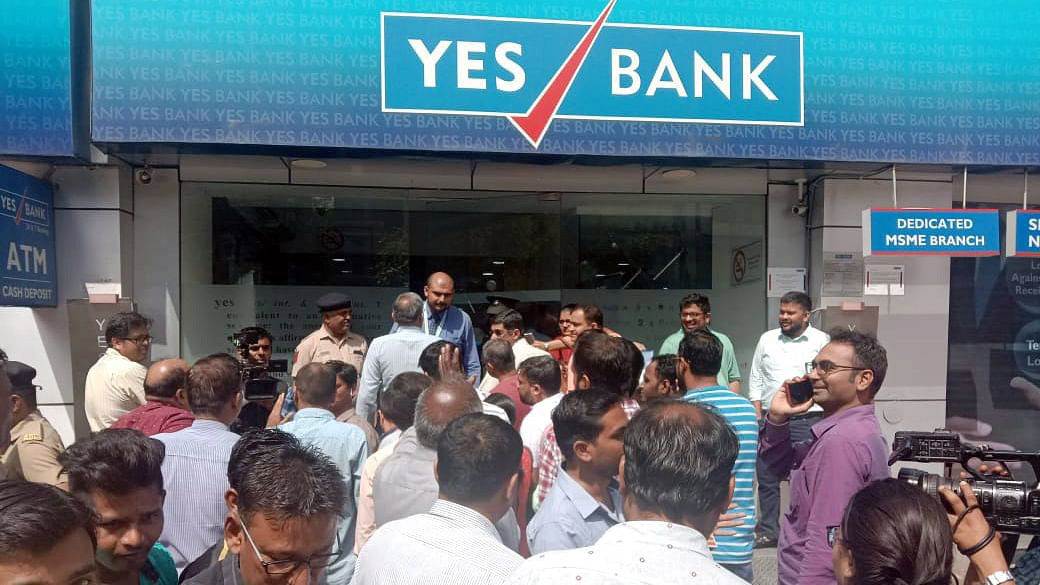
M. K. Venu
The real scam in the way Indian bank, Yes Bank, collapsed will unravel if you answer one simple question.
How did the bank grow its loan book by 80 per cent between March 31, 2017, and March 31, 2019, when the economy was down, credit demand unusually low with no signs of a pickup in private investment?
Yes Bank’s loan book grew from Rs1,320 billion in FY2017 to Rs2,410 billion in FY2019. That is an increase of Rs1,090 billion or 80 per cent in just two years, when most banks were finding it difficult to lend. In just two years, Yes Bank nearly doubled the loan book it had built over the previous 17 years of its existence.
Who were the corporate clients that the private sector lender so heavily and indiscriminately lent to in those two years – post-demonetisation and GST – when the investment climate seemed so utterly gloomy that no genuine companies were seeking loans for fresh investment?
After all, that is unprecedented loan growth in times of an investment drought. So, the first question to be asked is which corporate clients benefited from Yes Bank’s 80 per cent loan growth? The second, and perhaps more interesting question, is whether these companies made fresh investments or merely used Yes Bank’s funds to keep their older loans from other banks from turning into NPAs (non-performing assets)?
Finance minister Nirmala Sitharaman will do well to answer this question rather than just lazily put all the blame on the previous UPA (United Progressive Alliance) regime.
The finance minister must also explain how the overall loan growth of the bank during the full five years of the NDA (National Democratic Alliance) regime was nearly 400 per cent – from Rs550 billion in FY 2014 to 2,410 billion in FY 2019.
So, how was Yes Bank thriving when other banks were struggling to lend? The answer to this question constitutes the anatomy of a scam which needs serious investigation by a multi-agency probe. Not the kind of symbolic raid that the Enforcement Directorate (ED) conducted late on Friday at the residence of erstwhile promoter Rana Kapoor who ran a highly centralised operation in the bank.
My broad understanding is Yes Bank’s unusually large loan disbursals were made to already stressed corporate groups, some of whom were named specifically by the finance minister on Friday. These companies had already gamed the PSU banking system and run up a massive debt which they were struggling to repay. These corporations had enough clout to further game the system by using new bank loans to prevent old loans from being declared NPAs. It was a kind of Ponzi scheme happening on an industrial (pun intended) scale.
Yes Bank may have become a pawn in this elaborate Ponzi scheme, which also involved large non-banking financial companies (NBFCs) like Dewan Housing and perhaps others.
There are forensic audit reports from KPMG and PwC on how NBFCs were diverting large funds via shell companies to crony corporate groups who were struggling to repay loans. No wonder Yes Bank and these NBFCs were accounting for nearly 80 per cent of all loan growth post-demonetisation and GST. All this was going on even as the finance ministry and the RBI were sleeping on their job. Nirmala Sitharaman cannot blame this on the UPA.
So, suddenly we have massive NPAs emerging from new loans given in the last three-four years to support old loans which were already going bad. Good money was being thrown after bad money already committed in badly executed real estate and assorted infrastructure projects.
This is precisely what the former chief economic adviser in the Modi government, Arvind Subramanian, described as the ‘twin plus twin balance sheet problem’. The first twin balance sheet problem – when huge bad loans affected both corporate and bank balance sheets – occurred during the UPA regime. However, the second twin balance sheet problem – captured by Yes Bank’s stressed assets of nearly Rs600 billion – happened squarely under the NDA’s watch. The size of the problem is so huge that even the RBI has not dared to find the truth by doing a genuine asset quality review of the NBFCs which have gone bust. The last reported quarter of Yes Bank (July-September 2019) shows NPAs of some 5-6 per cent of the total loan book. Actually, it is about 30 per cent, or even more, because the economy has deteriorated further in the past four quarters.
The government will do well to first acknowledge this problem. Only then will it find the necessary solutions. The collapse of Yes Bank and its takeover by the RBI has come at a particularly bad time when the coronavirus is threatening to shave off one percentage point from global growth. A fragile financial system is not what we want at this juncture. The finance minister will do well to build confidence rather than blame the opposition for all the ills.
On Friday, Prime Minister Narendra Modi said at a summit that, “We will stand by the honest .. and deal strictly with cronyism.” It is another matter that a key sponsor of the summit was Yes Bank. We have to live with such contradictions, after all.
- The article first appeared in The Wire
Follow this link to join our WhatsApp group: Join Now
Be Part of Quality Journalism |
Quality journalism takes a lot of time, money and hard work to produce and despite all the hardships we still do it. Our reporters and editors are working overtime in Kashmir and beyond to cover what you care about, break big stories, and expose injustices that can change lives. Today more people are reading Kashmir Observer than ever, but only a handful are paying while advertising revenues are falling fast. |
| ACT NOW |
| MONTHLY | Rs 100 | |
| YEARLY | Rs 1000 | |
| LIFETIME | Rs 10000 | |













